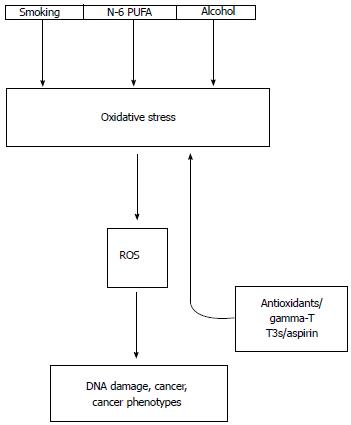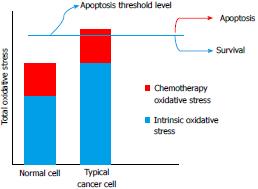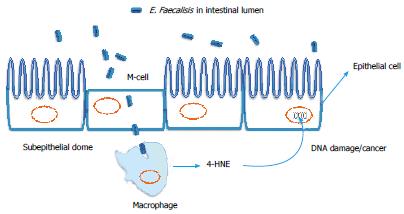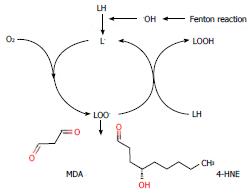Copyright
©2014 Baishideng Publishing Group Co.
World J Gastrointest Oncol. Mar 15, 2014; 6(3): 55-66
Published online Mar 15, 2014. doi: 10.4251/wjgo.v6.i3.55
Published online Mar 15, 2014. doi: 10.4251/wjgo.v6.i3.55
Figure 1 Connections between known risk factors of colorectal cancer and oxidative stress.
Smoking, dietary n-6 polyunsaturated fatty acids (n-6 PUFA) and heavy alcohol consumption contribute to in vivo oxidative stress with an accompanying overproduction of genotoxic reactive oxygen species (ROS) that give rise to mutations, cancer and also promote cancer phenotypes. Antioxidants such as gamma-tocopherol (gamma-T), tocotrienols (T3s) and aspirin reduce oxidative stress and ROS overproduction (up arrow).
Figure 2 Conceptual framework for the selective action of chemotherapeutic agents that induce oxidative stress.
Many cancer cells show a high level of intrinsic oxidative stress (“blue” component of total oxidative stress) compared to normal cells. Chemotherapeutic agents often act by inducing an additional level of oxidative stress (“red” component of total oxidative stress) that is sufficient to reach an apoptotic threshold (blue line) in a typical cancer cell but not a normal cell.
Figure 3 Role of pro-oxidant intestinal bacteria in colorectal cancer.
Enterococcus faecalis (E. faecalis) an intestinal bacteria with the unique ability to generate superoxide radicals. Intestinal microfold cells (M-cells) may transport E. faecalis from the intestinal lumen to macrophages in the subepithelial dome where macrophage cyclooxygenase-2 (COX-2) and lipid peroxidation can generate 4-hydroxynonenal (4-HNE), which promotes DNA damage/chromosomal instability to nearby epithelial cells[20].
Figure 4 Lipid peroxidation and mutagens.
Lipids containing PUFA (LH) are oxidized to form damaging lipid peroxy radicals (LOO.). These radicals can generate mutagenic aldehydes such as malondialdehyde (MDA) and 4-hydroxy-2-nonenal (4-HNE) from n-6 PUFAs. Lipid peroxidation can be initiated by the formation of highly reactive hydroxyl radicals (.OH) arising from the Fenton reaction.
Figure 5 Lipid peroxidation, smoking and the activation of benzo[a]pyrene.
Lipid peroxidation and cytochrome P450 2S1 (CYP2S1) can activate benzo[a]pyrene (BaP) to the potent mutagen, benzo[a]pyrene-r-7,t-8-dihydrodiol-t-9,10-epoxide (BaP-diol-t-epoxide). A high expression of CYP2S1 is associated with colorectal cancer and a poor prognosis (see text).
- Citation: Stone WL, Krishnan K, Campbell SE, Palau VE. The role of antioxidants and pro-oxidants in colon cancer. World J Gastrointest Oncol 2014; 6(3): 55-66
- URL: https://www.wjgnet.com/1948-5204/full/v6/i3/55.htm
- DOI: https://dx.doi.org/10.4251/wjgo.v6.i3.55

















